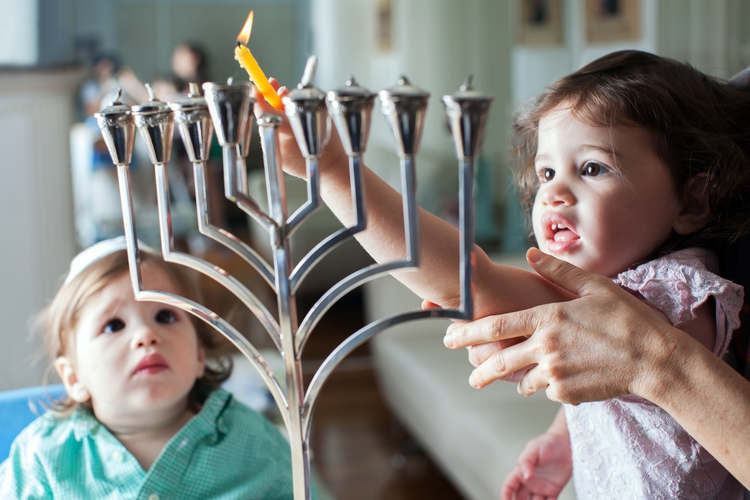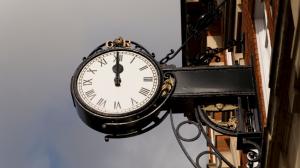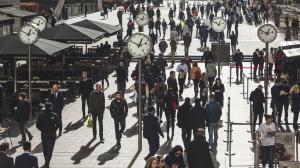
Best Comet of 2025?
C/2024 G3 (ATLAS) has already become very faintly visible to the naked eye for observers in the Southern Hemisphere.
Jewish holidays and festivals celebrate Jewish history as well as religious and cultural traditions. Themes often include remembrance, renewal, gratitude, and reflection on Jewish history.

People of the Jewish faith light a candle every day during Hanukkah.
©iStockphoto.com/tovfla
Jewish holidays, also known as Jewish festivals or Jewish holy days, celebrate various aspects of Jewish history, religious significance, and cultural traditions. Here are some of the major Jewish holidays and what they commemorate:
These are some of the major Jewish holidays, but there are many other minor holidays and fasts that hold special significance for various Jewish communities and traditions.
Public holidays in your country
The calendar that fixes Jewish religious holidays is lunisolar. It takes into account both the time it takes for the Earth to revolve around the Sun, and the time it takes the Moon to revolve around the Earth.
According to Jewish religious texts, the beginning of a month in the Jewish calendar, also called Rosh Chodesh, determines the date of most Jewish holidays. Like their Islamic counterpart, Jewish months also begin after the Crescent Moon becomes visible.
In ancient times, religious authorities had to physically observe the Crescent Moon to declare the start of a month and, therefore, the dates of Jewish religious holidays. In the fourth century, religious scholars introduced a fixed Jewish calendar. In the calendar, the beginning of the Jewish month is calculated using complex astronomical and mathematical rules.
The dates of traditional Jewish holidays are therefore fixed within the Jewish calendar but tend to vary within the Gregorian calendar.
A Jewish day begins and ends at nightfall, while a day in the Gregorian calendar goes from midnight to midnight. This means that Jewish holidays usually span two days in the Gregorian calendar, from one evening to the next.
Moonrise and moonset in your city
At timeanddate.com, we show the first full day of the holiday in our calendars and yearly holiday lists for countries.
What defines nightfall varies, whether it is sunset, when the Sun disappears behind the horizon, or when three medium-sized stars are visible.
What can you see in your night sky?
Because of this, Jewish people tend to be strict about their observances, starting many holidays and fasts just before sunset and ending the observation at nightfall the next day when the three stars are visible. Consequently, holidays like Tisha B’Av, Yom Kippur, and the Shabbat last around 25 hours. Shabbat is the weekly Jewish day of rest and lasts from Friday to Saturday.
Many Jewish people outside Israel observe a holiday for two days instead of the one day observed by the inhabitants of Israel. This custom goes back thousands of years when a month was determined after visual confirmation of the Moon in Jerusalem. Since there was no easy way to inform the diaspora that a month had begun, Jewish people outside Jerusalem would observe a holiday on two days to be safe.
The only exception to this custom is Yom Kippur, which is a one-day holiday all over the world—it would be too difficult for observers to fast for 50 hours without any break.
At timeanddate.com, we only show the official date of the holiday within the fixed Hebrew calendar. Please contact the relevant local authorities to find out if they observe a holiday for one or two days.
The holidays of most religions listed on timeanddate.com are observances. This means businesses and schools will generally remain open. This is also true for Jewish holidays outside of Israel: While the state of Israel has made many Jewish holidays into public holidays, countries like the United States do not base their public holidays on Jewish religious festivals and observances.
Employees can negotiate with their employers for time off for religious holidays, but in many countries, employers are not legally obliged to grant Paid Time Off (PTO) for religious observances.

C/2024 G3 (ATLAS) has already become very faintly visible to the naked eye for observers in the Southern Hemisphere.

How does the 12-hour clock system work? Is midnight 12 am or 12 pm?

Why do many countries set the clocks back and forth an hour twice a year?

Why are there 12 months? How long are they, and what do the month names mean?